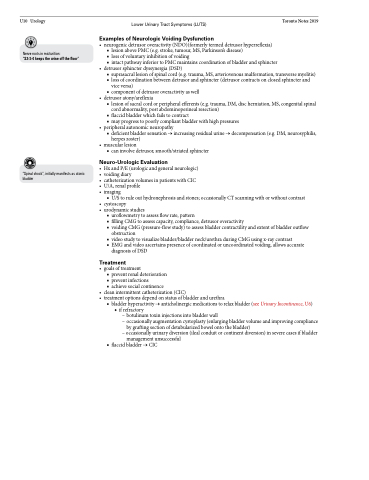Page 1328 - TNFlipTest
P. 1328
U10 Urology
Lower Urinary Tract Symptoms (LUTS)
Toronto Notes 2019
Nerve roots in micturition:
“S2-3-4 keeps the urine off the floor”
Examples of Neurologic Voiding Dysfunction
• neurogenicdetrusoroveractivity(NDO)(formerlytermeddetrusorhyperreflexia)
■ lesion above PMC (e.g. stroke, tumour, MS, Parkinson’s disease)
■ loss of voluntary inhibition of voiding
■ intact pathway inferior to PMC maintains coordination of bladder and sphincter
• detrusorsphincterdyssynergia(DSD)
■ suprasacral lesion of spinal cord (e.g. trauma, MS, arteriovenous malformation, transverse myelitis) ■ loss of coordination between detrusor and sphincter (detrusor contracts on closed sphincter and
vice versa)
■ component of detrusor overactivity as well
• detrusoratony/areflexia
■ lesion of sacral cord or peripheral efferents (e.g. trauma, DM, disc herniation, MS, congenital spinal
cord abnormality, post abdominoperineal resection)
■ flaccid bladder which fails to contract
■ may progress to poorly compliant bladder with high pressures
• peripheralautonomicneuropathy
■ deficient bladder sensation → increasing residual urine → decompensation (e.g. DM, neurosyphilis,
herpes zoster) • muscularlesion
■ can involve detrusor, smooth/striated sphincter
Neuro-Urologic Evaluation
• HxandP/E(urologicandgeneralneurologic) • voidingdiary
• catheterizationvolumesinpatientswithCIC • U/A,renalprofile
• imaging
■ U/S to rule out hydronephrosis and stones; occasionally CT scanning with or without contrast
• cystoscopy
• urodynamicstudies
■ uroflowmetry to assess flow rate, pattern
■ filling CMG to assess capacity, compliance, detrusor overactivity
■ voiding CMG (pressure-flow study) to assess bladder contractility and extent of bladder outflow
obstruction
■ video study to visualize bladder/bladder neck/urethra during CMG using x-ray contrast
■ EMG and video ascertains presence of coordinated or uncoordinated voiding, allows accurate
diagnosis of DSD
Treatment
• goalsoftreatment
■ prevent renal deterioration ■ prevent infections
■ achieve social continence
• cleanintermittentcatheterization(CIC)
• treatmentoptionsdependonstatusofbladderandurethra
■ bladderhyperactivity→anticholinergicmedicationstorelaxbladder(seeUrinaryIncontinence,U6) ◆ if refractory
– botulinum toxin injections into bladder wall
– occasionally augmentation cystoplasty (enlarging bladder volume and improving compliance
by grafting section of detubularized bowel onto the bladder)
– occasionally urinary diversion (ileal conduit or continent diversion) in severe cases if bladder
management unsuccessful ■ flaccidbladder→CIC
“Spinal shock”, initially manifests as atonic bladder


